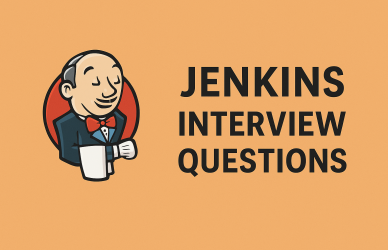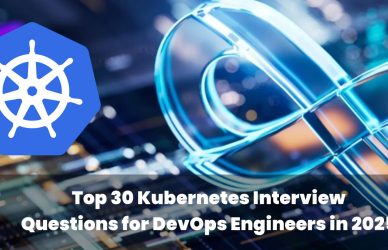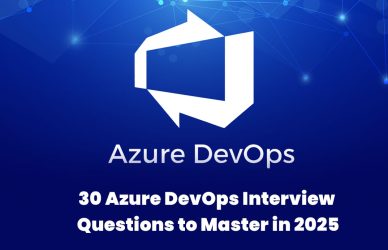Preparing for a Cloud/DevOps job interview requires a balanced mix of technical expertise, hands-on problem-solving, and excellent soft skills. Employers are on the lookout for candidates who not only demonstrate proficiency with cloud platforms, automation tools, and DevOps practices but also fit well within collaborative, fast-paced teams. In this guide, we’ll cover common technical and behavioral interview questions, coding challenges, and the soft skills that will set you apart in a competitive job market.
Common Technical Interview Questions
Technical questions in Cloud/DevOps interviews assess your knowledge of cloud platforms (e.g., AWS, Azure, GCP), Infrastructure as Code (IaC), CI/CD pipelines, containerization, and monitoring. Below are frequently asked questions, grouped by category, with guidance on how to approach them:
Cloud Platforms
What is the difference between EC2 and Lambda in AWS?
Approach: Explain that EC2 provides virtual servers for full control over the OS and applications, while Lambda is a serverless compute service for event-driven tasks. Highlight use cases (e.g., EC2 for web servers, Lambda for short-lived tasks).
Tip: Discuss scalability and cost differences (e.g., Lambda’s pay-per-use model).
How would you secure a cloud environment?
Approach: Discuss the shared responsibility model, then outline steps like enabling MFA, using IAM roles, encrypting data (e.g., S3 buckets with SSE-KMS), and setting up VPCs with security groups.
Tip: Reference specific tools like AWS Shield or Azure Security Center if relevant.
Explain the difference between horizontal and vertical scaling in the cloud.
Approach: Define horizontal scaling (adding more instances) and vertical scaling (increasing instance resources). Discuss trade-offs (e.g., horizontal for stateless apps, vertical for databases).
Tip: Mention auto-scaling groups in AWS or similar features in other clouds.
Infrastructure as Code (IaC)
What are the benefits of using Terraform over CloudFormation?
Approach: Highlight Terraform’s multi-cloud support and declarative syntax versus CloudFormation’s AWS-specific JSON/YAML. Discuss state management and community modules.
Tip: Acknowledge trade-offs (e.g., CloudFormation’s native AWS integration).
How do you handle drift in infrastructure managed by IaC tools?
Approach: Explain infrastructure drift (manual changes causing misalignment). Describe using terraform plan to detect drift and terraform apply to reconcile it.
Tip: Mention version control and CI/CD integration for IaC.
CI/CD and Automation
How would you set up a CI/CD pipeline for a microservices application?
Approach: Outline a pipeline using tools like Jenkins, GitHub Actions, or GitLab CI. Describe stages: code commit, build, test, deploy (e.g., to Kubernetes). Mention container registries (e.g., Docker Hub, ECR).
Tip: Emphasize blue-green deployments or canary releases for reliability.
What is the difference between Jenkins and GitLab CI?
Approach: Compare Jenkins (open-source, plugin-based) with GitLab CI (integrated with GitLab, YAML-based). Discuss setup complexity and scalability.
Tip: Share a use case where one might be preferred (e.g., GitLab CI for GitLab-hosted repos).
Containerization and Orchestration
What is the difference between Docker and Kubernetes?
Approach: Explain that Docker creates and runs containers, while Kubernetes orchestrates them (e.g., scaling, load balancing). Describe how they complement each other.
Tip: Mention alternatives like Podman or ECS.
How do you troubleshoot a pod that’s stuck in a CrashLoopBackOff state in Kubernetes?
Approach: Describe checking logs (kubectl logs), events (kubectl describe pod), and resource limits. Suggest common fixes (e.g., correcting environment variables, increasing memory).
Tip: Emphasize methodical debugging and tools like kubectl.
Monitoring and Logging
How do you monitor the performance of a cloud-based application?
Approach: Discuss tools like Prometheus, Grafana, or cloud-native solutions (e.g., AWS CloudWatch, Azure Monitor). Explain metrics (CPU, memory, latency) and alerting setups.
Tip: Mention log aggregation with ELK Stack or CloudWatch Logs Insights.
General Tip for Technical Questions:
Structure your answers using the STAR method (Situation, Task, Action, Result) when possible, even for technical scenarios.
If you’re unsure, explain your thought process and how you’d find the answer (e.g., “I’d check the AWS documentation or use kubectl debug”).
Tailor answers to the job’s tech stack (e.g., focus on Azure for an Azure-heavy role).
Common Coding Challenges
Cloud/DevOps interviews often include coding or scripting challenges to test your ability to automate tasks, manage infrastructure, or troubleshoot systems. These challenges can be done on a whiteboard, in a shared editor, or as take-home assignments. Here are common types of challenges and how to prepare:
1. Scripting for Automation
Challenge: Write a Bash or Python script to automate log rotation for an application.
Example: Create a script that archives logs older than 7 days and deletes archives older than 30 days.
Solution Approach:
Explain: File handling, cron scheduling, and error handling (e.g., checking if directories exist).
Tip: Practice scripting with find, grep, and awk for log manipulation.
2. Infrastructure as Code
Challenge: Write a Terraform configuration to deploy a load-balanced web server on AWS.
Example: Create an EC2 instance behind an Application Load Balancer (ALB).
Solution Approach:
Explain: Modules, variables, and outputs. Highlight security group configurations.
Tip: Practice Terraform or CloudFormation for common resources (VPC, EC2, RDS).
3. CI/CD Pipeline Setup
Challenge: Configure a GitHub Actions workflow to build and deploy a Dockerized app.
Example: Build a Node.js app, push the image to Docker Hub, and deploy to an EC2 instance.
Solution Approach:
Explain: Secrets management and deployment steps (e.g., SSH to EC2 for deployment).
Tip: Familiarize yourself with YAML syntax and pipeline tools like Jenkins or CircleCI.
4. Troubleshooting Scenarios
Challenge: Debug a failing Kubernetes deployment where pods aren’t starting.
Example: Given a YAML file, identify issues like incorrect image tags or missing secrets.
Solution Approach:
-
Check pod status:
kubectl get pods -
Inspect events:
kubectl describe pod <pod-name> -
Fix issues: (e.g., update image tag in
deployment.yaml)
Tip: Practice kubectl commands and common failure modes (e.g., resource limits, networking).
Preparation Tips for Coding Challenges
-
Practice Platforms: Use LeetCode, HackerRank, or DevOps-specific platforms like KodeKloud Labs for hands-on labs.
-
Tools to Master: Bash, Python, Terraform, Docker, Kubernetes, and CI/CD tools (Jenkins, GitHub Actions).
-
Show Your Process: Talk through your approach, even if the solution isn’t perfect. Employers value problem-solving over flawless code.
-
Test Your Code: If time allows, explain how you’d validate your script (e.g., dry runs for Terraform, unit tests for pipelines).
ommon Behavioral Interview Questions
Behavioral questions evaluate your soft skills, teamwork, and ability to handle real-world DevOps challenges. Employers want to see how you collaborate, solve problems, and adapt in high-pressure environments. Use the STAR method (Situation, Task, Action, Result) to structure your responses.
1. Tell me about a time you automated a repetitive task. What was the impact?
Sample Answer:
- Situation: At my previous job, our team spent hours manually deploying updates to a web application.
- Task: I was tasked with reducing deployment time to improve efficiency.
- Action: I implemented a Jenkins pipeline to automate build, test, and deployment to AWS ECS using Docker containers. I also documented the process for the team.
- Result: Deployment time dropped from 2 hours to 15 minutes, and the team could focus on feature development.
Tip: Quantify results (e.g., time saved, error reduction) and mention tools used.
2. Describe a situation where you resolved a production outage.
Sample Answer:
- Situation: A critical API went down due to a misconfigured load balancer during a release.
- Task: As the on-call DevOps engineer, I needed to restore service quickly.
- Action: I checked CloudWatch logs, identified the misconfiguration in the ALB’s health checks, and rolled back the change using Terraform. I also set up alerts to catch similar issues in the future.
- Result: Service was restored in 20 minutes, and we avoided future outages with better monitoring.
Tip: Highlight calmness under pressure and post-incident improvements (e.g., root cause analysis).
3. How do you handle disagreements with a developer over a deployment strategy?
Sample Answer:
- Situation: A developer wanted to deploy directly to production, bypassing our CI/CD pipeline.
- Task: I needed to ensure compliance with our release process without causing friction.
- Action: I explained the risks of manual deployments (e.g., untested code) and showed how the pipeline ensured quality. I also offered to streamline the pipeline to address their concerns.
- Result: The developer agreed to use the pipeline, and we reduced pipeline runtime by 10%.
Tip: Emphasize collaboration, communication, and a focus on shared goals.
4. Tell me about a time you learned a new tool or technology to solve a problem.
Sample Answer:
- Situation: Our team needed to migrate from monolithic servers to Kubernetes for scalability.
- Task: I was responsible for leading the migration but had limited Kubernetes experience.
- Action: I took an online Kubernetes course, set up a local cluster with Minikube, and tested deployments. I also collaborated with a senior engineer for guidance.
- Result: We successfully migrated the app, achieving 99.9% uptime and 50% faster scaling.
Tip: Show initiative and a growth mindset.
5. How do you prioritize tasks during a busy sprint?
Sample Answer:
- Situation: During a sprint, I was juggling pipeline optimizations and a security audit.
- Task: I needed to balance both to meet deadlines without compromising quality.
- Action: I used a Kanban board to track tasks, prioritized security fixes due to compliance requirements, and delegated routine pipeline updates to a junior engineer after training them.
- Result: We completed the audit on time and improved pipeline efficiency by 20%.
Tip: Demonstrate time management and teamwork.
General Tip for Behavioral Questions:
- Prepare 3–5 stories from your experience that cover automation, troubleshooting, teamwork, and learning. Adapt them to fit different questions.
- Be concise but specific, focusing on your role and measurable outcomes.
- Practice aloud to ensure your answers are clear and confident.
Soft Skills Employers Seek in Cloud/DevOps Candidates
In addition to technical expertise, Cloud/DevOps roles require strong soft skills due to their collaborative and dynamic nature. Employers prioritize candidates who excel in:
Communication:
- Why It Matters: DevOps engineers bridge development and operations, explaining technical concepts to non-technical stakeholders (e.g., product managers) and documenting processes.
- How to Demonstrate: Use clear, jargon-free language in interviews. Share examples of writing runbooks, presenting to teams, or training colleagues.
- Example: “I created a Confluence page to document our CI/CD pipeline, which reduced onboarding time for new hires by 30%.”
Collaboration and Teamwork:
- Why It Matters: DevOps emphasizes cross-functional teams, requiring you to work with developers, QA, and security teams.
- How to Demonstrate: Highlight projects where you aligned teams or resolved conflicts (e.g., mediating between developers and ops on release schedules).
- Example: “I facilitated a workshop to align dev and ops on Kubernetes adoption, fostering better collaboration.”
Problem-Solving and Adaptability:
- Why It Matters: Cloud/DevOps roles involve troubleshooting complex systems and adapting to new tools or outages.
- How to Demonstrate: Share stories of debugging incidents or learning new technologies under pressure.
- Example: “When a database outage occurred, I used CloudWatch and query optimization to restore performance in under an hour.”
Attention to Detail:
- Why It Matters: Small errors in scripts or configurations can cause outages or security risks.
- How to Demonstrate: Mention peer reviews, testing IaC changes, or catching bugs in pipelines.
- Example: “I caught a misconfigured IAM role during a code review, preventing unauthorized access to our S3 bucket.”
Time Management and Prioritization:
- Why It Matters: DevOps engineers juggle multiple tasks (e.g., monitoring, deployments, security patches) in fast-paced environments.
- How to Demonstrate: Discuss how you prioritize critical tasks or use tools like Jira to stay organized.
- Example: “I used a priority matrix to focus on a critical security patch while delegating routine monitoring tasks.”
Empathy and Emotional Intelligence:
- Why It Matters: DevOps requires understanding team dynamics and supporting colleagues during high-stress incidents.
- How to Demonstrate: Share examples of mentoring peers or maintaining calm during outages.
- Example: “During a late-night outage, I kept the team focused and acknowledged everyone’s efforts, boosting morale.”
How to Showcase Soft Skills in Interviews:
- Weave soft skills into your STAR stories (e.g., “I communicated the outage resolution to stakeholders clearly”).
- Show enthusiasm for teamwork and learning, as cultural fit is critical in DevOps roles.
- Ask thoughtful questions (e.g., “How does the team handle post-incident reviews?”) to demonstrate engagement.
Additional Tips to Ace the Interview
Research the Company’s Tech Stack:
- Check the job description and company website for tools they use (e.g., AWS, Kubernetes, Jenkins). Tailor your answers to their environment.
- Example: If they use Azure, emphasize your experience with Azure DevOps or AKS.
Prepare Questions for the Interviewer:
- Ask about their DevOps culture, incident response processes, or adoption of new tools (e.g., “Are you exploring GitOps or AIOps?”).
- This shows interest and helps you assess if the role aligns with your goals.
Build a Portfolio:
- Create a GitHub repo with sample scripts, Terraform modules, or pipeline configs. Mention it during the interview to showcase hands-on experience.
- Example: “I have a repo with a Terraform module for deploying VPCs, which I can share.”
Practice Whiteboard and Live Coding:
- Simulate whiteboard sessions or live coding with a friend or mentor. Focus on explaining your thought process.
- Use tools like CoderPad or HackerRank for practice.
Stay Calm Under Pressure:
- If you’re stuck on a question, take a deep breath and say, “Let me think through this.” Break the problem into steps and verbalize your approach.
- Employers value resilience and clarity over perfection.
Follow Up After the Interview:
- Send a concise thank-you email within 24 hours, reiterating your enthusiasm and mentioning a specific topic discussed (e.g., their use of Prometheus).
- Example: “Thank you for discussing your Kubernetes setup. I’m excited about contributing to your team’s scalability goals.”
Resources for Preparation
- Technical Practice: KodeKloud Labs, A Cloud Guru, LeetCode, HackerRank.
- Interview Prep: “Cracking the Coding Interview” by Gayle Laakmann McDowell, “The DevOps Handbook” by Gene Kim, YouTube channels like TechWorld with Nana for DevOps tutorials.
- Portfolio Building: GitHub, Personal blog (e.g., “How I Built a CI/CD Pipeline with GitHub Actions”).
- Soft Skills: Practice STAR responses, “Soft Skills: The Software Developer’s Life Manual” by John Sonmez.
With cloud and DevOps roles ranking among the most sought-after tech jobs in 2025, competition is fierce. Candidates are expected to master both infrastructure tooling and team collaboration. If you’re applying for a cloud or DevOps engineering position, preparing effectively can be the difference between getting shortlisted and being overlooked.
This article walks you through the most common technical and behavioral questions, coding exercises, and professional soft skills you need to nail your next interview.
Understanding the DevOps Hiring Process
A typical DevOps or cloud engineering interview involves several stages:
- Initial Screening: Covers your background, tech stack, certifications, and cloud experience.
- Technical Deep Dive: Interviewers explore your hands-on expertise with pipelines, IaC, containers, and cloud services.
- Live or Take-home Challenge: You might write a Terraform module, debug a pipeline, or diagram a cloud solution.
- Behavioral Interview: Assesses soft skills like teamwork, leadership, and adaptability.
- Final Team Round: Usually involves engineers, product managers, or a hiring manager for cultural fit.
Startups may streamline this process, while large enterprises typically have standardized interview tracks.
Key Technical Topics Interviewers Focus On
Hiring managers expect you to be proficient with:
- CI/CD Tools – GitHub Actions, Jenkins, GitLab CI/CD
- Containers and Kubernetes – Helm charts, namespaces, autoscaling
- Infrastructure as Code (IaC) – Terraform, AWS CloudFormation, Pulumi
- Cloud Providers – Deep familiarity with at least one (AWS, Azure, GCP)
- Monitoring and Logging – Prometheus, Grafana, ELK stack, Datadog







